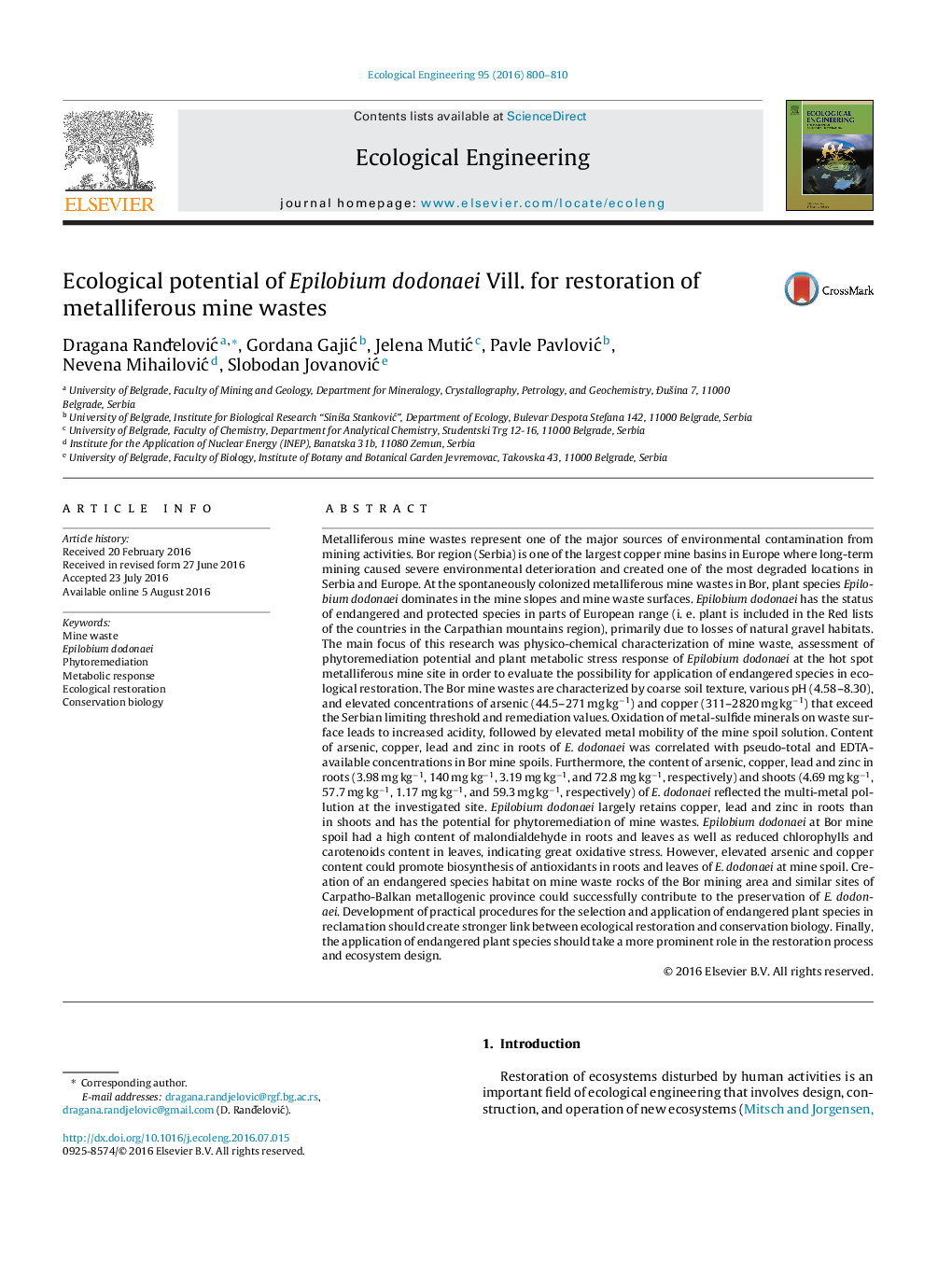| Article ID | Journal | Published Year | Pages | File Type |
|---|---|---|---|---|
| 4388511 | Ecological Engineering | 2016 | 11 Pages |
•Paper integrates conservation biology of endengered Epilobium dodonaei with phytoremediation and ecological restoration.•Epilobium dodonaei has phytostabilization potential at hot spot mine site Bor.•Metal(loid) induces oxidative stress and promotes biosynthesis of antioxidants in E. dodonaei.•Endangered E. dodonaei can be used for the restoration of gravel metalliferous mine wastes.
Metalliferous mine wastes represent one of the major sources of environmental contamination from mining activities. Bor region (Serbia) is one of the largest copper mine basins in Europe where long-term mining caused severe environmental deterioration and created one of the most degraded locations in Serbia and Europe. At the spontaneously colonized metalliferous mine wastes in Bor, plant species Epilobium dodonaei dominates in the mine slopes and mine waste surfaces. Epilobium dodonaei has the status of endangered and protected species in parts of European range (i. e. plant is included in the Red lists of the countries in the Carpathian mountains region), primarily due to losses of natural gravel habitats. The main focus of this research was physico-chemical characterization of mine waste, assessment of phytoremediation potential and plant metabolic stress response of Epilobium dodonaei at the hot spot metalliferous mine site in order to evaluate the possibility for application of endangered species in ecological restoration. The Bor mine wastes are characterized by coarse soil texture, various pH (4.58–8.30), and elevated concentrations of arsenic (44.5–271 mg kg−1) and copper (311–2820 mg kg−1) that exceed the Serbian limiting threshold and remediation values. Oxidation of metal-sulfide minerals on waste surface leads to increased acidity, followed by elevated metal mobility of the mine spoil solution. Content of arsenic, copper, lead and zinc in roots of E. dodonaei was correlated with pseudo-total and EDTA-available concentrations in Bor mine spoils. Furthermore, the content of arsenic, copper, lead and zinc in roots (3.98 mg kg−1, 140 mg kg−1, 3.19 mg kg−1, and 72.8 mg kg−1, respectively) and shoots (4.69 mg kg−1, 57.7 mg kg−1, 1.17 mg kg−1, and 59.3 mg kg−1, respectively) of E. dodonaei reflected the multi-metal pollution at the investigated site. Epilobium dodonaei largely retains copper, lead and zinc in roots than in shoots and has the potential for phytoremediation of mine wastes. Epilobium dodonaei at Bor mine spoil had a high content of malondialdehyde in roots and leaves as well as reduced chlorophylls and carotenoids content in leaves, indicating great oxidative stress. However, elevated arsenic and copper content could promote biosynthesis of antioxidants in roots and leaves of E. dodonaei at mine spoil. Creation of an endangered species habitat on mine waste rocks of the Bor mining area and similar sites of Carpatho-Balkan metallogenic province could successfully contribute to the preservation of E. dodonaei. Development of practical procedures for the selection and application of endangered plant species in reclamation should create stronger link between ecological restoration and conservation biology. Finally, the application of endangered plant species should take a more prominent role in the restoration process and ecosystem design.
